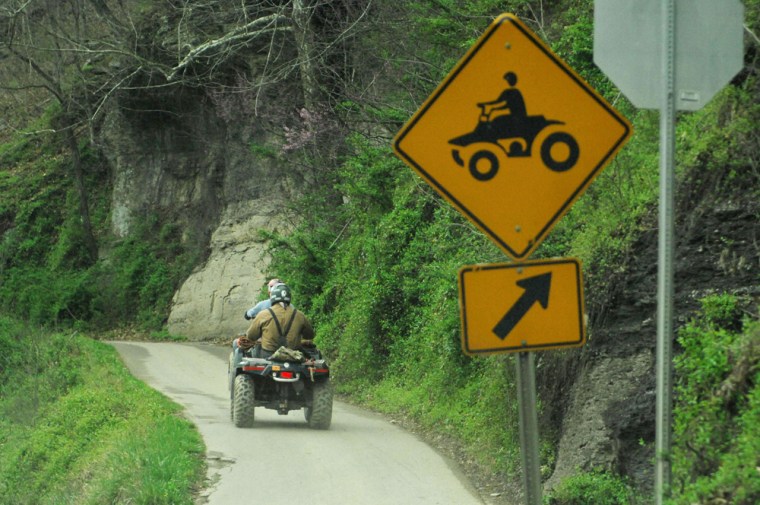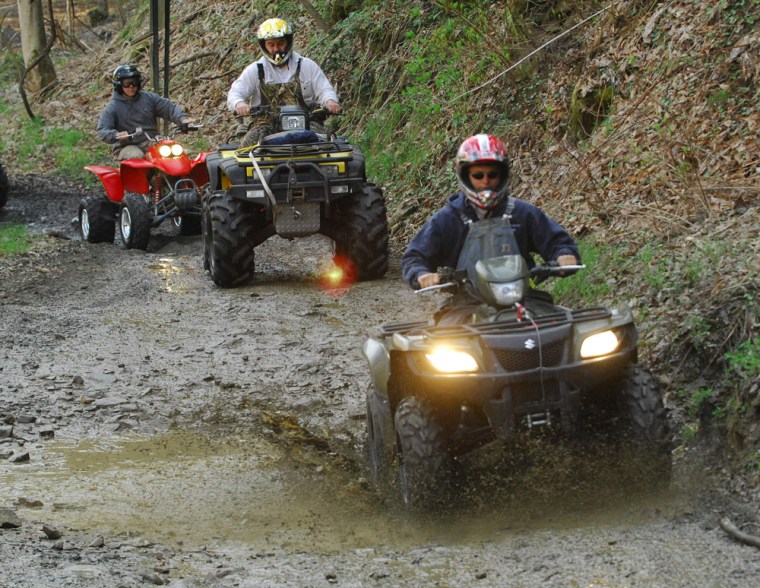Kendell Simpson rolls along a rocky, muddy path into the forest. His strapped-on helmet, waterproof suit and goggles are the only indication of what lies ahead.
Then he starts the rocky climb, the roar of his all-terrain vehicle getting louder as he gives the Rhino more gas and maneuvers around boulders and mud puddles.
The Rockhouse trailhead starts out steep, with tight turns. Then it gets even steeper.
"You haven't seen nothing yet," Simpson says with a grin.
He ought to know. More than a decade ago, Simpson helped launch the Hatfield-McCoy Trail System, which has grown into a network of some 550 miles of riding trails for four-wheelers.
Each of the six Hatfield-McCoy trails has a distinct vibe. While Pinnacle Creek's runs are known for breathtaking mountain views, the highly challenging trails of Dingess Rum may provide the best adrenaline rush. Organizers say there's a trail for everyone, depending on skill level.
The trail system is named after two infamous families — the Hatfields of southern West Virginia and the McCoys of eastern Kentucky, who carried on a 12-year feud of debatable origin more than a century ago. Some say it started over a stolen hog.

The idea behind the Hatfield-McCoy trails was to trigger economic development in nine counties hit hard by the decline of coal and timber industries.
The auto body shop that Simpson and son-in-law Bill Reed run in the town of Gilbert is already doing more business, renting and repairing four-wheelers, and equipping riders with gear. But everyone involved in the venture says there's unrealized potential.
"This thing is really in its infancy, we're really just getting started," said Greg Crigger, a customer-service coordinator for the trail system and one of its few full-time employees. "The ultimate goal is somewhere in the neighborhood of 2,000 miles of trail, all connected in this eight- or nine-county project area."
While the Hatfield-McCoy project is unique because it's all on private land, it was patterned after the 900-mile Paiute ATV Trail in Utah, which uses public land and crosses the Fishlake National Forest.
And with the sale of ATVs booming, demand for places to ride could be on the upswing. The Specialty Vehicle Institute of America says sales have more than doubled, from 447,000 in 1998 to 912,000 in 2004. Nationwide, the Consumer Product Safety Commission estimates there are 7.6 million four-wheelers in use.
Russ Ehnes with the National Off-Highway Vehicle Conservation Council says there are other trail systems, but few as well known as the Hatfield-McCoy and Paiute trails. "Most of the national forests in the United States offer some degree of off-highway access. Some have complete trails and some don't," he said. "The Paiute and the Hatfield-McCoy trails are probably the best known and easiest to manage because they are marked so well."
The West Virginia trails were designed for many uses, including mountain bikes, horses and hikers. But they're most popular with ATV and dirt bike riders, who have turned them into a hot tourist attraction. And with affordable permits — $19 for a day, $37 for up to a week — many users are repeat visitors.
Todd Hershberger of Haymarket, Va., has been riding the trails for four years. On his most recent trip in March, he plowed his ATV through a giant, sloshing mud pit. It's not an official part of the trail, but it's too much fun for many riders to ignore. "I thought I was going to get stuck," he said, laughing about the experience as he wiped mud off his helmet and listened to his buddies' favorite trail stories. Hershberger and three friends make the eight-hour trip here once a year, then ride from dawn to dark.
"The trails change every year," he said. "The first year, some of the trails were rougher than they are now. Every year they change, and they add new trails, too, so it gives us more variety."
Though the trails are long, it's nearly impossible to get lost. Each is marked with a number and the other trails it intersects. Like ski slopes, they are also color-coded: Green are the easiest, blue are intermediate and black are the most difficult. Narrow orange trails are for motorcycles only. Most of the green trails are wide and generally smooth, maintained by gas companies that put the roads there years ago to get to their wells. Blue trails have tighter, uneven paths, more rocks and more obstacles to overcome, including fallen branches and mud holes. Black trails can be scary-steep, with massive boulders, more obstacles and heavy overgrowth.
Ken Shamy drove 650 miles from Monmouth Junction, N.J., to ride the 115-mile Browning Fork Trail for the second time. It's the longest of the trails, with terrain for all skill levels. "I just love it up here, just getting away. And the people are nice, too," he said.
Shamy was riding with Sam Rodriquez, who flew from Miami to Charleston, then rented a car for the two-hour drive south. "This is beautiful country," Rodriquez marveled. "God's country."
They and nine friends stayed at the Twin Hollow Campground, on the Browning Fork trail. You can camp, or rent four-person cabins with picturesque views for $99 a night.
Despite the remoteness of the trails, they have direct connections to towns offering food, fuel, hotels and motels. Some communities even allow ATVs on the street, as long as they bear a Hatfield-McCoy permit.
Expansion plans include a new visitors' center in Boone County, equestrian and hiking trails, partnerships with state parks and packages with whitewater rafting companies.
"I'd say they could make a killing if they had massage people set up here in the evenings," said Jessica Carpenter of Parkersburg, who rode the trail for the first time recently with her husband, aunt and uncle.
"I'm sore," she added, "but I had a blast."
